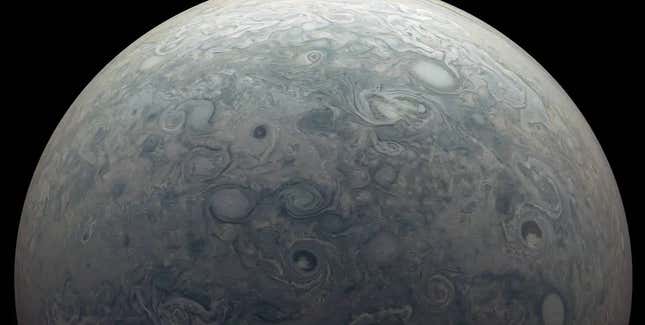Jupiter, who hurt you? Last month, NASA’s Juno mission spotted a region of the gas giant’s atmosphere forming an abject face, complete with wide eyes, a nose, and frowning mouth.
The despondent face was imaged on September 7, during the Juno spacecraft’s 54th close flyby of Jupiter. Juno arrived in Jupiter’s orbit in July 2016, and since then has been studying the gas giant’s turbulent atmosphere, its weather, and aspects of the planet’s moons.
Advertisement
The image was shared across NASA channels after being made by Vladimir Tarasov, a citizen scientist who was perusing JunoCam’s raw image data. The image was taken about 4,800 miles (7,700 km) above Jupiter, and can be seen in JunoCam’s publicly accessible raw images library here.
Advertisement
Juno’s had a busy docket lately: earlier this month, NASA released images from the spacecraft’s most recent flyby of the planet’s moon Io. Other spacecraft are also studying Jupiter, which is the largest planet in our solar system; just last week, the Webb Space Telescope spotted a high-speed jet in the planet’s atmosphere.
Advertisement
The region photographed by Juno is called Jet N7, and it sits in Jupiter’s northern reaches, around 69 degrees north. The image is taken along Jupiter’s terminator—a very metal descriptor for the line between day and night sides of the planet. The gloomy face looms on the dayside of the divider.

Advertisement
Jet N7 was previously visited, most recently on a Juno flyby in May 2023. But this time, the area didn’t appear particularly pleased to see the NASA spacecraft soaring above it. Clouds in the image look like a human face, albeit a slightly distorted one. Oblong dark eyes are framed by clouds that form an errant eyebrow and a nose, complete with nostrils. Towards the bottom of the ‘face’ is a crescent-shaped cloud formation, forming the figure’s deep frown.
The image is an example of pareidolia, which causes us humans to see patterns like faces in unrelated structures. (The man on the Moon is a classic example of this.) In 2020, a European satellite imaged what looked like an angel in a dune field on Mars. The year before, a galactic collision took on a ghostly—or, as commenters noted, C3PO-like—face.
Advertisement
Jupiter’s clouds are dynamic, so the figure on its surface is not forever—the face in our Moon will almost certainly outlast it. But I sure hope things get better for the fleeting face.
More: Webb Telescope Reveals a High-Speed Jet on Jupiter
Services Marketplace – Listings, Bookings & Reviews